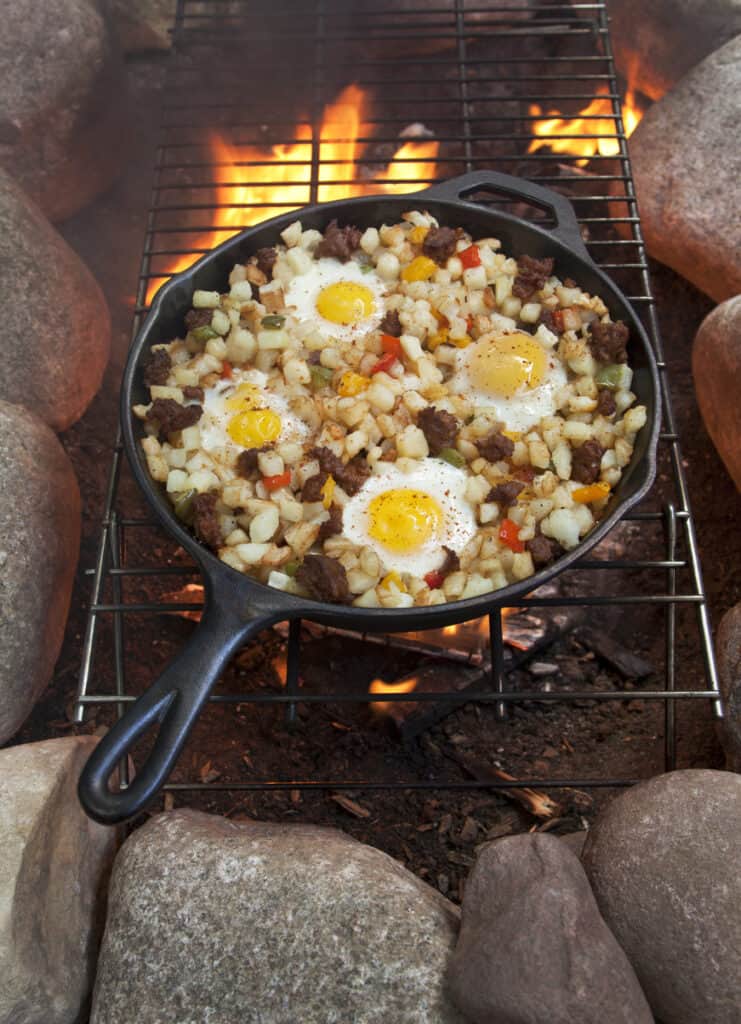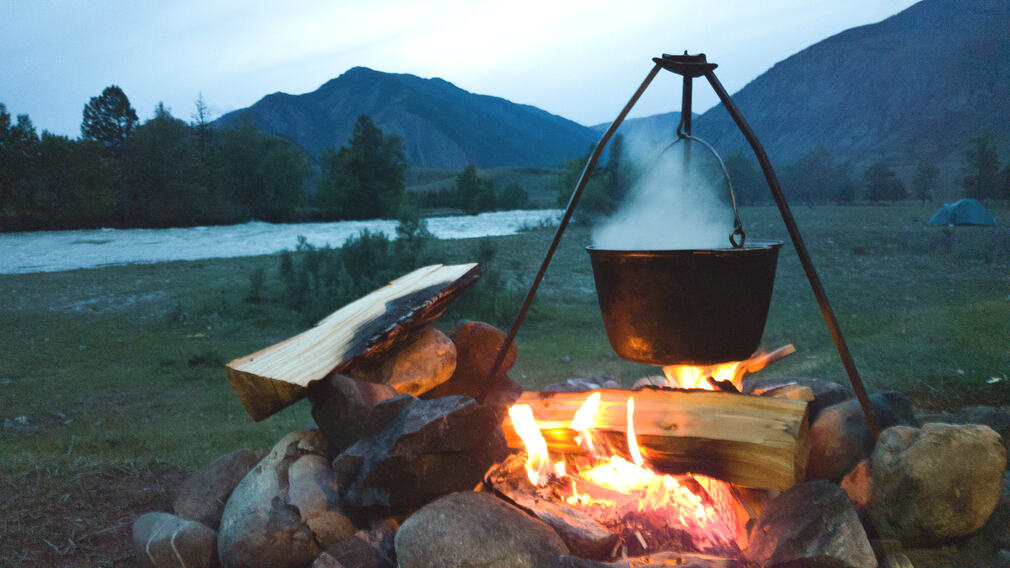Dispersed camping offers a unique opportunity to connect with nature, but it also presents challenges when it comes to meal planning. This guide will help you prepare delicious, nutritious, and easy-to-make meals for your dispersed camping adventures.
Understanding Dispersed Camping Food Needs
When planning meals for dispersed camping, consider:
- Energy requirements: You’ll likely burn more calories than usual. Hiking, setting up camp, and other outdoor activities increase your caloric needs. Plan for high-energy, nutrient-dense foods to keep you fueled.
- Weight and space limitations: Pack lightweight, compact foods. Every ounce counts when you’re carrying all your supplies. Opt for dehydrated or freeze-dried options to save weight and space.
- Lack of refrigeration: Focus on non-perishable items. Without a cooler, you’ll need foods that can safely last at ambient temperatures for the duration of your trip.
- Limited cooking equipment: Plan simple, one-pot meals. Complex recipes are challenging with minimal cooking gear, so aim for meals that can be prepared easily with just a pot or pan.
Understanding these needs helps you plan meals that are not only satisfying but also practical for the dispersed camping environment. It’s about finding the right balance between nutrition, taste, and convenience.

Essential Cooking Gear
- Lightweight stove and fuel: A compact, efficient stove is crucial for hot meals. Consider factors like fuel type, burn time, and weight when choosing.
- Pot or pan (consider a multi-use option like a Jetboil): Look for durable, lightweight options. A pot with a lid can double as a mixing bowl or eating vessel.
- Utensils: Spork, knife, and a multi-tool. A spork combines a spoon and fork, saving space. A good knife is essential for food prep, and a multi-tool can handle various camp tasks.
- Mug or cup: Useful for hot drinks and can double as a measuring cup.
- Water filtration system: This is essential for safe drinking water from natural sources. Based on your needs and preferences, choose between filters, purifiers, or chemical treatments.
This basic kit allows you to prepare a wide variety of meals while keeping your pack light. Remember, every item should serve a purpose, and multi-use gear is ideal for dispersed camping.
Meal Planning Strategies
- Pre-trip preparation: Measure and pack ingredients in advance. This saves time at camp and reduces the risk of spills or waste.
- When possible, use dehydrated or freeze-dried foods. These are lightweight, compact, and have a long shelf life.
- Plan no-cook meals for some days to save fuel. This is especially useful for lunches or days when you’re on the move.
- Bring versatile ingredients that can be used in multiple meals. This adds variety to your menu without adding extra weight.
Effective meal planning ensures you have nutritious, enjoyable food throughout your trip while minimizing weight and waste. It’s worth spending time before your trip to plan out each meal and snack.
Breakfast Ideas
- Instant oatmeal with dried fruits and nuts: A classic, warming breakfast that’s easy to customize.
- Granola with powdered milk: Add water to the powdered milk for a quick, crunchy breakfast.
- Breakfast bars or energy bars: Great for early starts or when you need to eat on the go.
- Instant coffee or tea: For that essential morning caffeine boost.
- Dehydrated egg scramble with veggies: A more substantial hot breakfast option for when you have time to cook.
Breakfast is crucial for providing energy for the day ahead. These options offer a mix of quick, no-cook choices and more elaborate hot meals to suit different camping scenarios.
Lunch and Snack Ideas
- Trail mix (nuts, dried fruits, chocolate): A classic energy-boosting snack that’s easy to eat while hiking.
- Energy bars or protein bars: Convenient, nutrient-dense options for quick refueling.
- Jerky (beef, turkey, or plant-based): High-protein snack that keeps well without refrigeration.
- Hard cheeses and crackers: Provide a good balance of protein and carbs. Hard cheeses can last several days without refrigeration.
- Nut butter and tortillas: A simple, high-energy lunch that’s easy to prepare.
- Tuna or salmon in pouches: Adds protein to your meals without the need for a can opener.
These lunch and snack options provide a mix of protein, carbs, and fats to keep you energized throughout the day. They’re easy to pack, require little to no preparation, and can be eaten on the go.
Dinner Ideas
- Dehydrated meals (homemade or store-bought): These are lightweight and easy to prepare: just add hot water.
- Instant rice or couscous with dehydrated vegetables and spices: A versatile base that can be customized with different veggies and seasonings.
- Pasta with olive oil and parmesan cheese: A simple, comforting meal that’s easy to prepare.
- Lentil soup mix with added spices: Nutritious and filling, lentils are a great source of protein and fiber.
- Instant mashed potatoes with bacon bits and cheese: A hearty, satisfying meal that’s quick to prepare.
Dinner is often the most substantial meal of the day when camping. These options provide a good balance of carbohydrates and proteins to replenish energy after a day of outdoor activities. They’re designed to be easy to prepare with minimal cooking equipment while still providing a satisfying and tasty meal. Consider pre-packaging your own meal combinations at home to save time and reduce waste at the campsite.
No-Cook Meal Options
- Wraps with nut butter and banana: A quick, energy-packed meal that requires no preparation.
- Cold-soaked oatmeal: Prepare this the night before for a ready-to-eat breakfast.
- Bagels with cream cheese and smoked salmon: A more gourmet option that’s still easy to assemble.
- Pre-made energy balls or bars: Great for quick energy boosts or when you don’t want to stop for a full meal.
No-cook meals are ideal for days when you want to save fuel or time or when the weather isn’t conducive to cooking. They’re also great for lunch on the trail when you don’t want to stop and set up your stove. These options provide a mix of quick energy and sustained nutrition, perfect for keeping you fueled during your outdoor activities.
Hydration and Drinks
- Water (filtered from natural sources): Always your primary source of hydration.
- Electrolyte powder mixes: Help replace minerals lost through sweat during strenuous activities.
- Instant coffee or tea bags: For that necessary caffeine boost in the morning or during breaks.
- Hot chocolate mix for a treat: A comforting drink that can boost morale, especially in cold weather.
Proper hydration is crucial during outdoor activities. While water should be your main source of hydration, adding variety with other drinks can make staying hydrated more enjoyable and help replace lost electrolytes. Remember to drink regularly, even if you don’t feel thirsty, as dehydration can set in quickly during outdoor activities.
Food Safety and Storage
- Use bear-resistant containers in bear country: This is often a requirement and crucial for your safety and wildlife protection.
- Hang food properly when required: In areas without bear canisters, proper food-hanging techniques are essential.
- Practice Leave No Trace principles: This includes proper food storage and waste disposal.
- Pack out all trash and food scraps: Leave no trace of your meals to protect wildlife and preserve the natural environment.
Proper food storage is not just about keeping your supplies safe; it’s also about protecting wildlife and preserving the natural environment. Always check local regulations regarding food storage in your camping area. Remember, even small food particles or scented items can attract wildlife, so be thorough in your storage and cleaning practices.
Tips for Successful Dispersed Camping Meals
- Test meals at home before your trip: This ensures you like the taste and know how to prepare them.
- Pack spices in small containers to add flavor: This can greatly enhance simple meals.
- Bring a variety of textures and flavors to prevent food fatigue: Eating the same thing every day can get monotonous.
- Consider the season and pack accordingly (more hot meals for cold weather): Your body’s needs change with the weather.
- Don’t forget comfort foods for morale boosting: Sometimes, a favorite snack can make a big difference in your camping experience.
Conclusion
By following these guidelines and ideas, you can enjoy nutritious and tasty meals during your dispersed camping adventures. Remember to always check local regulations regarding food storage and campfire use in your chosen camping area. For more information on regulations, check out our guide on understanding dispersed camping regulations.
To make your trip planning easier, consider using digital tools. Our article on planning your dispersed camping trip using digital tools can help you streamline your preparation process.
Happy camping and bon appétit!

Leave a Reply